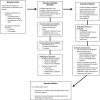Biomarkers of lupus nephritis histology and flare: deciphering the relevant amidst the noise
- PMID: 28391335
- PMCID: PMC5837441
- DOI: 10.1093/ndt/gfw300
Biomarkers of lupus nephritis histology and flare: deciphering the relevant amidst the noise
Abstract
Biomarker development in lupus nephritis (LN) has traditionally relied on comparing the characteristics of candidate markers to clinical findings in patients and controls from cross-sectional cohorts. In this work, two additional strategies for LN biomarker development that are gaining ground will be discussed. One approach compares analytes directly to kidney histology. The second strategy utilizes longitudinal measurements of biomarker levels at regular intervals as patients move from disease quiescence to disease flare. These approaches have begun to empower biomarkers as diagnostic and prognostic tools in LN and have revealed novel and sometimes unexpected roles for these biomarkers in the pathogenesis and prediction of LN disease activity.
Keywords: discovery and validation; longitudinal cohort; urine analyte.
© The Author 2017. Published by Oxford University Press on behalf of ERA-EDTA. All rights reserved.
Figures



Similar articles
-
Prediction Of Renal Flare In Adult Patients With Lupus Induced Nephritis.J Ayub Med Coll Abbottabad. 2021 Jan-Mar;33(1):9-13. J Ayub Med Coll Abbottabad. 2021. PMID: 33774946
-
Biomarkers in lupus nephritis.Int J Rheum Dis. 2015 Feb;18(2):219-32. doi: 10.1111/1756-185X.12602. Int J Rheum Dis. 2015. PMID: 25884459 Review.
-
Urine S100 proteins as potential biomarkers of lupus nephritis activity.Arthritis Res Ther. 2017 Oct 24;19(1):242. doi: 10.1186/s13075-017-1444-4. Arthritis Res Ther. 2017. PMID: 29065913 Free PMC article.
-
Urine Galectin-3 binding protein reflects nephritis activity in systemic lupus erythematosus.Lupus. 2023 Feb;32(2):252-262. doi: 10.1177/09612033221145534. Epub 2022 Dec 12. Lupus. 2023. PMID: 36508734 Free PMC article.
-
Prognostic and Diagnostic Values of Novel Serum and Urine Biomarkers in Lupus Nephritis: A Systematic Review.Am J Nephrol. 2021;52(7):559-571. doi: 10.1159/000517852. Epub 2021 Aug 13. Am J Nephrol. 2021. PMID: 34515043
Cited by
-
Urine proteomic signatures of histological class, activity, chronicity, and treatment response in lupus nephritis.JCI Insight. 2024 Jan 23;9(2):e172569. doi: 10.1172/jci.insight.172569. JCI Insight. 2024. PMID: 38258904 Free PMC article.
-
Alternative pathway diagnostics.Immunol Rev. 2023 Jan;313(1):225-238. doi: 10.1111/imr.13156. Epub 2022 Oct 28. Immunol Rev. 2023. PMID: 36305168 Free PMC article. Review.
-
Precision medicine in lupus nephritis: can biomarkers get us there?Transl Res. 2018 Nov;201:26-39. doi: 10.1016/j.trsl.2018.08.002. Epub 2018 Aug 10. Transl Res. 2018. PMID: 30179587 Free PMC article. Review.
-
Adhesion molecules: a way to understand lupus.Reumatologia. 2022;60(2):133-141. doi: 10.5114/reum.2022.115664. Epub 2022 May 18. Reumatologia. 2022. PMID: 35782027 Free PMC article. Review.
-
[Lupus nephritis].Z Rheumatol. 2018 Sep;77(7):593-608. doi: 10.1007/s00393-018-0496-4. Z Rheumatol. 2018. PMID: 29955955 German.
References
-
- Malvar A, Pirruccio P, Alberton V, et al. Histologic versus clinical remission in proliferative lupus nephritis. Nephrol Dial Transplant 2015; doi: 10.1093/ndt/gfv296doi:10.1093/ndt/gfv296 - DOI - PMC - PubMed
-
- Rovin BH, Song H, Birmingham DJ, et al. Urine chemokines as biomarkers of human systemic lupus erythematosus activity. J Am Soc Nephrol 2005; 16: 467–473 - PubMed
Publication types
MeSH terms
Substances
Grants and funding
LinkOut - more resources
Full Text Sources
Other Literature Sources

